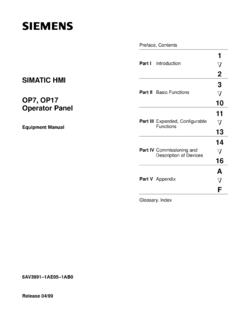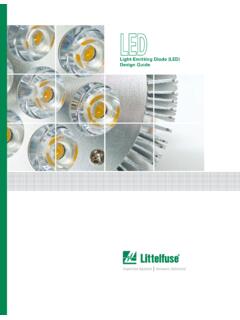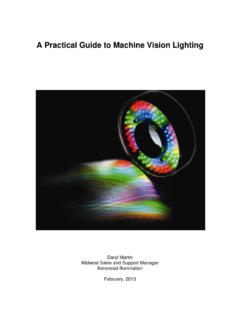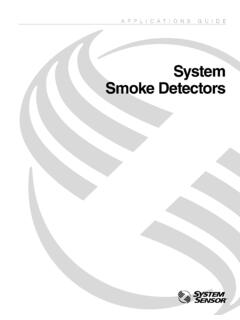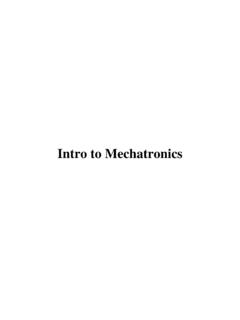Transcription of Instrumentation and Control - Energy
1 Instrumentation and Control Qualification Standard DOE-STD-1162-2013 June 2013 Reference Guide The Functional Area Qualification Standard References Guides are developed to assist operators, maintenance personnel, and the technical staff in the acquisition of technical competence and qualification within the Technical Qualification Program (TQP). Please direct your questions or comments related to this document to the Office of Leadership and Career Management, TQP Manager, NNSA Albuquerque Complex. This page is intentionally blank. Table of Contents FIGURES .. iii TABLES .. v VIDEOS .. v ACRONYMS .. vii PURPOSE .. 1 SCOPE .. 1 PREFACE .. 1 1. Instrumentation and Control (I&C) personnel must demonstrate a familiarity level knowledge of basic electrical engineering fundamentals.. 2 2. I&C personnel must demonstrate a familiarity level knowledge of basic mechanical engineering fundamentals, including thermodynamics and hydraulics.
2 32 3. I&C personnel must demonstrate a familiarity level knowledge of basic civil/structural engineering fundamentals.. 51 4. I &C personnel must demonstrate a familiarity level knowledge of basic chemical engineering fundamentals.. 57 5. I&C personnel must demonstrate a working level knowledge of basic I&C systems fundamentals and their applications in process systems operations.. 60 6. I&C personnel must demonstrate a familiarity level knowledge of specialty Instrumentation and its applications.. 106 7. I&C personnel must demonstrate a familiarity level knowledge of application of digital systems in I&C systems design.. 112 8. I&C personnel must demonstrate a working level knowledge of I&C Systems Design and Analysis.. 139 9. I&C personnel must demonstrate a familiarity level knowledge of procurement, installation, and testing.. 190 10. I&C personnel must demonstrate a familiarity level knowledge of operations and maintenance of I&C systems.
3 202 11. I&C personnel must demonstrate a working level knowledge of the configuration management process applied to I&C systems documentation.. 205 12. I&C personnel must demonstrate a working level knowledge of life cycle management.. 211 13. I&C personnel must demonstrate a working level knowledge of surveillance and assessment techniques, reporting, and follow up actions for I&C systems and programmatic elements. 223 ii 14. I&C personnel must demonstrate a working level knowledge of problem analysis principles, and the ability to apply techniques as necessary to identify problems, determine potential causes of problems, and identify potential corrective actions.. 228 15. I&C personnel must demonstrate a working level knowledge of process and Instrumentation diagrams (P&IDs), logic diagrams, electrical schematics, loop diagrams for I&C systems, construction drawings, as-built drawings, and wiring diagrams.. 236 16. I&C personnel must demonstrate a familiarity level knowledge of DOE and industry codes and standards and their applicability as they relate to I&C systems design, procurement, installation, testing, operations, and maintenance.
4 I&C personnel must also demonstrate the ability to evaluate compliance with applicable DOE and industry codes and standards. If listed documents have been superseded or replaced, the latest version should be used.. 237 FIGURES Figure 1. Measurement with voltmeter 2 Figure 2. Circuit diagram 5 Figure 3. Impedance vector 6 Figure 4. Printed circuit board and resistors 12 Figure 5. High voltage switchgear 13 Figure 6. Digital ammeter 17 Figure 7. Simple ladder diagram 24 Figure 8. Sample circuit 25 Figure 9. Relay logic circuit 25 Figure 10. Continuous circuit 26 Figure 11. Ladder diagram for a load device 27 Figure 12. Short circuit 27 Figure 13. Corrected ground fault 28 Figure 14. Electrical signal analysis 29 Figure 15. Gate valve 34 Figure 16. Relief valve 36 Figure 17. Electric Solenoid Actuator 38 Figure 18. Typical piston actuators 39 Figure 19. Diaphragm actuator 40 Figure 20. Valve and actuator configurations 41 Figure 21.
5 Direct acting actuator and reverse acting Control valve 42 Figure 22. Centrifugal pump 43 Figure 23. Mechanical seal 44 Figure 24. Seismic Instrumentation systems 55 Figure 25. Bellows type detector 60 Figure 26. Bourdon tube 61 Figure 27. Typical resistance thermometer 65 Figure 28. Orifice plate internal view 67 Figure 29. Venturi tube 68 Figure 30. Dall flow tube 69 Figure 31. Ball float 72 Figure 32. Slide valve 73 iii Figure 33. Diaphragm valve 73 Figure 34. Chain float 73 Figure 35. Magnetic bond method 74 Figure 36. Conductivity probe method 75 Figure 37. Differential pressure detector 75 Figure 38. Block and arrows 78 Figure 39. Summing points 79 Figure 40. Takeoff point 79 Figure 41. Feedback Control system block diagram 80 Figure 42. Lube oil cooler temperature Control system and equivalent block diagram 81 Figure 43. Types of oscillations 84 Figure 44. Basic logic symbols 85 Figure 45. Conventions for multiple inputs 86 Figure 46.
6 Coincidence gate 86 Figure 47. EXCLUSIVE OR and EXCLUSIVE NOR gates 86 Figure 48. Symbols for complex devices 88 Figure 49. Chlorine induced cracking 106 Figure 50. Handheld refractometer 112 Figure 51. Smart transmitter 113 Figure 52. A simple PLC 115 Figure 53. A circuit and PLC program 117 Figure 54. An energized circuit and PLC 118 Figure 55. Unactuated system 119 Figure 56. Actuated system 120 Figure 57. Circuit with multiple relays 121 Figure 58. Simple process 145 Figure 59. Example of safe limit range 147 Figure 60. An automotive cruise Control system 152 Figure 61. Example Control rules 153 Figure 62. Basic PID controller 153 Figure 63. Life cycle steps for SISs 159 Figure 64. Example of redundancy 163 Figure 65. Stuck-at faults: (a) A bipolar XNOR gate, (b) A CMOS inverter 178 Figure 66. Mapping Physical Defects onto Faults a) metal mask with dust causing extra metal, b) failure mode a short c) faults on the logic level stuck-at faults d) bridging faults 179 Figure 67.
7 Bridging faults voting model 180 Figure 68. Change in functionality due to bridging faults 181 Figure 69. Alarm management life cycle 185 Figure 70. Main steps in classifying SSCs 195 Figure 71. Assignment of SSCs to safety classes 199 Figure 72. Configuration management interfaces 206 Figure 73. Compiling the set of CM SSCs 210 Figure 74. Lifecycle steps 212 Figure 75. Typical trend chart 215 Figure 76. Chart with little variation 216 Figure 77. Impossible numbers 216 iv Figure 78. Things gone wrong 217 Figure 79. Trend with an abnormal spike 217 Figure 80. Reference bars 218 Figure 81. Positioner 221 Figure 82. FMEA form example 230 TABLES Table 1. Codes for safety-significant and safety-class Instrumentation , Control , and alarm components .. 20 Table 2. Vibration Criteria for Sensitive Equipment .. 53 Table 3. Computational grand challenges for materials and process design in the chemical enterprise .. 57 Table 4. Summary of Instrument Design.
8 102 Table 5. Examples for safe limits .. 146 Table 6. Comparison of the PID terms proportional, integral, and derivative to the terms gain, reset, and rate.. 149 Table 7. Calculations the controller makes to continually change the output as the PV 151 Table 8. SIL level and performance ranges for on-demand 160 Table 9. Design review principles .. 166 Table 10. Safety system functional requirements .. 175 Table 11. Safety-significant design criteria .. 176 Table 12. Most commonly used fault models .. 177 Table 13. Number of multiple stuck-at faults in an n-line circuit .. 179 Table 14. Bridging faults models for the circuit in figure 67 .. 181 Table 15. SIL level and performance ranges for on demand modes .. 213 Table 16. Failure table .. 220 VIDEOS Video 1. Voltage, current, and resistance .. 4 Video 2. Reactance .. 4 Video 3. Impedance .. 6 Video 4. Alternating and direct current .. 7 Video 5. Capacitors ..11 Video 6. Circuit breakers.
9 12 Video 7. How to use a voltmeter .. 17 Video 8. How to use an ohmmeter .. 18 Video 9. Relief valve .. 37 Video 10. Orifice plate .. 42 Video 11. Positive displacement pump operation .. 45 Video 12. Equipment qualification process .. 54 Video 13. Bourdon tube .. 61 Video 14. Pitot static tube introduction .. 70 Video 15. Replacing a gauge glass .. 71 Video 16. Functional requirements .. 107 Video 17. Radiation monitors .. 109 v Video 18. How to use a refractometer ..112 Video 19. What is a PLC .. 122 Video 20. Fieldbus .. 124 Video 21. Wireless Technology .. 129 Video 22. Digital Electronics .. 129 Video 23. Proportional controls .. 152 Video 24. Feedback controls .. 154 Video 25. BIBO 156 Video 26. Eigenvectors and eigenvalues .. 156 Video 27. Failure modes and effects analysis .. 232 vi ACRONYMS 24/7 twenty four hours a day, seven days a week AC alternating current ALARA as low as reasonably achievable ANS American Nuclear Society ANSI American National Standards Institute API American Petroleum Institute ASIC application specific integrated circuit ASME American Society of Mechanical Engineers ASRS alarm system requirements specification ASTM American Society for Testing and Materials BIBO bounded input bounded output BPCS basic process Control system BTP branch technical position CCF common cause failure COTS commercial off-the-shelf cm cubic meter CM configuration management CMOS complementary metal oxide semiconductor CPLD complex programmable logic device CPU central processing unit DC direct current DCS distributed Control system DD description document DO dissolved oxygen DOE Department Energy DSA documented safety analysis DSP digital signal processor DTL diode -transistor logic EDA electronic design automation EFCOG Energy Facilities
10 Contractor Group EMF electromotive force EPA Environmental Protection Agency ESA electrical signal analysis ES&H environment, safety, and health FAQS functional area qualification standard FDD facility design descriptions FIB focused ion beam FMEA failure modes and effects analysis FMEDA failure modes, effects, and diagnostic analysis FPGA field-programmable gate arrays FTA fault tree analysis GOCO government-owned contractor operated vii GOGO government-owned government-operated HEPA high-efficiency particulate air HFE human factors engineering HMA highly management alarm HMI human-machine interface HPE human performance evaluation HSI human-system interface HVAC heating, ventilation, air-conditioning IAEA International Atomic Energy Agency Hz hertz I&C Instrumentation and Control IEC International Electrotechnical Commission IEEE Institute for Electrical and Electronic Engineers I/O input/output IPL independent protection layer ISA International Society of Automation ISO International Organization for Standardization ITS International Temperature Scale kPa kilopascal KSA Knowledge, skills, and abilities kV kilovolts LAN local area network LCO limiting condition for operation LCS limiting Control setting LED light emitting diode LSSS limiting safety system setting MAWP maximum allowable working pressure MCSA motor current signature analysis MIP maintenance implementation plan MORT management oversight and risk tree MOS metal-oxide-semiconductor MOV motor operated valve mrad millirad mrem millirem MTBF mean time between failure NCTC normally-closed, timed-closed NCTO normally-closed.










